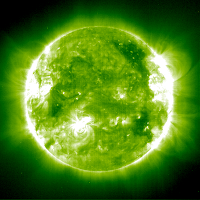 |
| Sun, green wavelengths filtered |
The simple answer is: no, but we don't see it because of how we perceive colours and because there are no stars that emit only green wavelengths.
Not satisfied?
Good, because we need to use some physics to understand why we don't percept green in stars.
Firstly, we see the stars because they emit light.
Light is an electromagnetic wave, also know as radiation and the different colours of light emitted depends on its wavelength. The visible range of wavelengths can be seen here.
Stars, for an empirical reason (but there is also an explanation for that), emit a spectrum, that is a range of wavelengths. Then, for example, a red star does not emit only "red wavelengths", but a specific range of wavelengths that include the red.
The star colour depends on its temperature: higher temperatures correspond to shorter wavelengths, that is "bluer" colours, and lower temperatures correspond to longer wavelengths, that is "redder" colours. Then, even if red is a warm colour and blue is a cold one, a blue star is actually much hotter than a red one.
Is this range of colours emitted with the same intensity? No, the intensity of each colour emitted follow a specific path, discovered with quantum physics, called blackbody radiation curve and you can find a cool toy (applet) to play with it here. For each temperature, there is a different path that includes a different range of colors.
Now let's see a bit how our eyes interpret spectra.
When we see a color of an object, we are actually seeing the composite color, that is the mix of the colors emitted (or reflected). Black and white are not really "colors" since black is just an absence of color, while white is formed by all the colors. A prune has that nice purple color because it basically reflects red and blue wavelengths and our eyes mix them up.
The same applies for stars, but you have to mix up a very large range of colours with different intensities.
Known that, let's use those information to answer the question.
The applet used before helps a lot: it mixes the colours under the curve and shows the composite result. You can change the temperature in Kelvin of the curve (i.e. of the star) on the bottom (our Sun has a surface temperature of 6000 Kelvin, very roughly).
When the temperature is low, the star is evidently red because there is almost no blue at all in the spectrum (or it has a very low intensity). It is clear also why very hot stars have a bluish colour, since in the spectrum the red colour has low intensity in respect to blue.
It is interesting to see what happens when we choose the peak near the green wavelength. The sum of the colours is white, not green!
You can't see green stars because of the nature of the star emission, in which the green color is included, but is not perceived by our eyes because it is mixed with all the other colors to form white.
No comments:
Post a Comment